Let’s start solving!
This tutorial should help you learn how to solve a 3×3 for the first time, so take the time to read the whole thing!
This method of solving is called the Beginner’s Method, which once learned can be used to solve the cube in anywhere from 1 to 7 minutes.
1. Cross
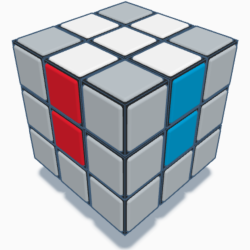
THE GOAL: make a white cross that has the edge colors lined up with the blue, red, green, and orange middles.
THE METHOD: Select an edge piece (to go into your cross; it will have white and another color on it), move it to be with the yellow middle, align, insert, repeat.
Select an Edge Piece: the unsolved cube can be very confusing; it gets less so when you have a clear focus, though. To do this, pick one edge piece that has both white and one other color on it. This will be the only piece that matters for now. Either of these pieces would work in this scramble; they both have white on them.
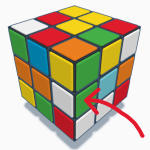
or

Move the Edge Piece: find the yellow center, and move the selected edge piece to be next to it. That would take the scramble above to:

or
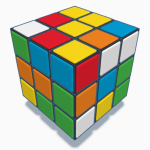
depending on which piece you picked.
Align the Edge Piece: the edge pieces have two colors, 1. white and 2. blue, red, green, or orange. Turning the top face, make it so that the edge piece you’ve chosen is between yellow and the other color on the edge piece. That’s pretty wordy, but see how I do it with orange?
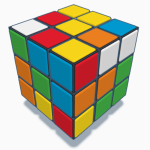
Insert the Edge Piece: If in that case above the white had been facing up on the piece we picked, you’d just rotate the orange face to put the edge piece next to the white middle. But since the white piece is next to the colored middle, face the colored middle towards you and do this algorithm: U’ R’ F R.

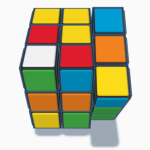

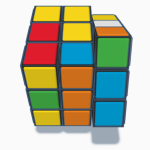
*Don’t know what the letters mean? Each algorithm links to the 3×3 algorithm notation page.
2. Corners
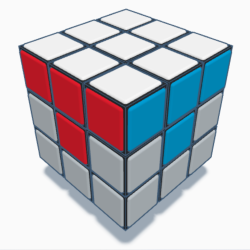
THE GOAL: get the whole white face solved, by inserting the white corners into the cross.
THE METHOD: select a corner piece, make sure it’s next to the yellow middle, the white side of the corner piece is facing right, align, insert, repeat.
Select a Corner Piece: again, pick a piece to focus on so that things aren’t overwhelming. This piece should have 3 colors on it, one of them white. Both of these corner pieces have white on them, as you can see:

Make Sure the Corner Piece is in the Top Layer: if the piece you’ve selected is already next to the yellow middle, move on. If it isn’t, follow the next steps to insert a different corner into its place (forcing it to the top), and then find it again.

Make Sure the Corner Piece is Facing Right: turn the cube so that the white cross faces down, and the corner piece you’ve picked is at the top right of the face you are looking at. If the white part of the corner piece is on the right side, continue. If not, do this algorithm once or twice to get it there: R U2 R’ U’ (it just rotates the piece).
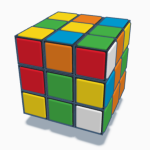
This one works, because white is facing to the right when I put the piece at the top right corner. Gotta love lucky scrambles!
Align the Corner Piece: now that the white side of your piece is facing right, turn the bottom two layers of the cube together till the side of the corner facing you matches the middle piece facing you.

Insert the Corner Piece: all that’s needed now is a simple algorithm, R U R‘. Make sure white is facing right; in this case red would face me.
3. Edges
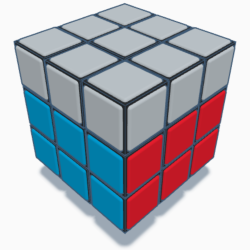
THE GOAL: complete the middle row.
THE METHOD: orient the cube, select a piece, make sure it isn’t in the middle row, align, insert, repeat.
Orient the Cube: previously it hasn’t been too important to have the cube facing the right way except for algorithms. From now on though, the white side will always face down.
Select an Edge Piece: The only rule here is that the piece you select have two colors on it, neither of them yellow. These are the pieces that go in the middle row.
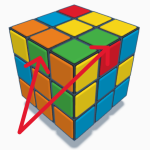
Both of these would work.
Make Sure it isn’t in the Middle Row: if your piece is touching the yellow middle, move on. If it isn’t, follow the steps ahead to put a different piece in its place, forcing it out. Then, find the piece again.
Align the Edge Piece: look at the edge piece in the top row that you chose. Move the bottom two layers till the color facing you matches a middle. Like this:
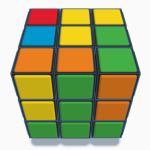
Insert the Edge Piece: there are two possible scenarios here. If the up facing color on your edge piece matches the middle piece on the right, do this algorithm: (U)(R U R’)(U’)(F’ U F) the parentheses are “units of thought” of the algorithm. If the up facing color matches the middle to the left, do the inversion of that algorithm: (U’)(L’ U L)(U’)(F U F’).
CAUTION: here is where the algorithms start getting a little less intuitive. It’s super fun to figure ’em out, but for not just always make sure you have the cube oriented the right way. Here, the upside down T should always face you, whether doing inverted or not.

The “up facing color” here is orange, and matches the orange middle. I’d use #1.
4. Yellow Cross
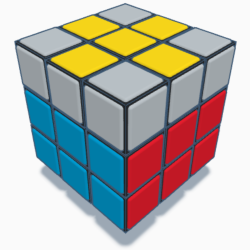
*Starting here, sometimes you’ll already have something like the yellow cross or the top corners done because of a great scramble! In that case, count yourself lucky and move on.*
THE GOAL: make a yellow cross (we don’t care about lining up middles yet though, they’ll be lined up later).
THE METHOD: orient the yellow side, do an algorithm, repeat if necessary. There are 3 cases, buckle in!
Case 1: remember that white ALWAYS faces down! Things don’t work otherwise. Case 1 is that there aren’t any yellow edges facing up. If that’s the case, it doesn’t matter which way the yellow top is facing, just do the cross algorithm: (F)(R U R’ U’)(F’). Now, move on to case 2.

Case 2: case 2 is that a yellow L appears on top. That isn’t counting the corners, which don’t matter at the moment. If that’s the case, turn the top layer till one piece faces right and the other towards you. Then, do the cross algorithm: (F)(R U R’ U’)(F’). Now, move on to case 3.
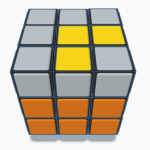
This is the way the L should face.
Case 3: case 3 is that a yellow line appears on top, again not counting corner pieces. If that’s the case, make the line horizontal (facing left and right). Then, do the cross algorithm: (F)(R U R’ U’)(F’).

Your Little Brother Got the Cube: Often when I’m solving my cube, I’ll reach this step and find that either 1 or 3 yellow pieces are facing up. There isn’t an algorithm for that because it can’t happen normally; so pop any yellow edge out, flip it, and put it back in the right way (I always put it back in to get the line case personally).
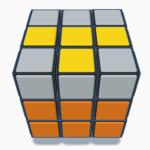
5. Yellow Face

THE GOAL: solve the yellow face by orienting the corners.
THE METHOD: select an unsolved corner, do an algorithm, repeat.
Select an Unsolved Corner: for this step, select a corner that doesn’t have its yellow side facing up. Rotate the top layer till that piece is in the bottom right (of the yellow face). Remember that the white face should always be down.
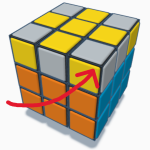
This corner shall be our victim.
Do an Algorithm: (R’ D’ R D)(R’ D’ R D), and don’t be dismayed, your progress isn’t gone!! Read on.

This is what it SHOULD look like; see how the piece we chose is rotated?
Repeat: normally repeating’s pretty simple, but watch out in this case. Once the piece you’ve chosen has yellow facing up, rotate the yellow face either direction to put an unsolved yellow piece there.
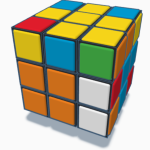
>

>
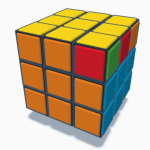
Your Little Brother Got the Cube: Here, it’s common a corner piece could be twisted. It looks like the whole face is solved except for one rotated piece. Just flip it to solve it.
6. Yellow Corners
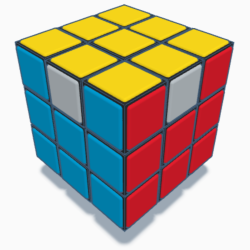
THE GOAL: match the yellow corners to the edges beneath them.
THE METHOD: align the cube for corners algorithm, use the corners algorithm. There are two possible cases at this point in solving the cube.
Case 1: There is a pair of adjacent corners that are solved. If this is the case, rotating the top layer should be able to match up two adjacent corners with the edges below them. This is the most common case. To solve it, face the two solved corners to the left. Then, rotate the cube so that white faces you. Finally, do the corners algorithm: (L2 D2)(L’ U’ L)(D2)(L’ U L’). Return the cube to white facing down.

In Case 1, you will be able to match up two adjacent corners with their side.
Case 2: There isn’t a pair of adjacent corners that are solved. If this is the case, simply turn the cube so that white is facing you without worrying which pair is facing left or not because there isn’t any pair to face left. Then do the corners algorithm: (L2 D2)(L’ U’ L)(D2)(L’ U L’). This will transform the cube to case 1.
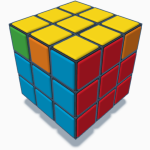
This is a Case 2 cube; no matter which way the top face is rotated two adjacent corners never line up.
7. Yellow Edges
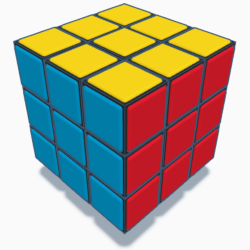
THE GOAL: match the yellow edges to the colors below them.
THE METHOD: align the cube for edges algorithm, use the edges algorithm. There are two possible cases at this point in solving the cube.
Case 1: one edge is solved and the other three are not. You can tell this is the case if 3 faces of the cube are solved (white, yellow, and orange for example) and the other three have one left to go. If this is the case, remember to keep white facing down and put the solved edge at the back of the cube. Then, if the piece in front needs to go to the right, do the edge algorithm: (F2)(U’ R’ L)(F2)(R L’ U’)(F2). If it needs to go to the left, do its inverse: (F2)(U R’ L)(F2)(R L’ U)(F2).
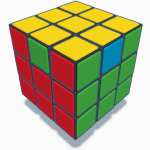
Orange is facing back here; so the green piece in front goes to the right.

Blue goes to the left, so this means do the inverse algorithm.
Case 2: Only two sides (white and yellow) are solved. In this case, do the edge algorithm (F2)(U’ R’ L)(F2)(R L’ U’)(F2) without caring which pieces face you. This will convert the cube to case 1.
Congrats!
Now you know how to solve a 3×3! There are only a few algorithms to memorize to be able to solve it memorized, and then you’re off to the races! Some great next resources are jperm’s guide to the CFOP method, and branching out to other cubes like the 2×2.
If you’re looking to advance your gear, GAN cubes where I got my cube and Amazon sell amazing gear like timers and speedcubes to up your game.
Good luck on your cubing adventure!
